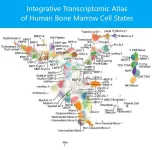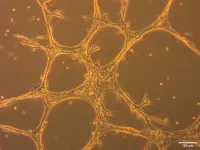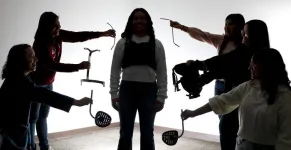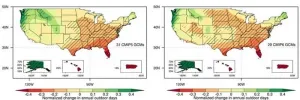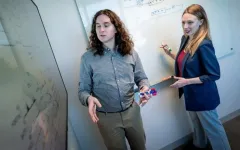(Press-News.org) Thanks to an unusual application of game theory and machine learning technology, a large team of scientists led by experts at Cincinnati Children’s has published the world’s most detailed “atlas” of the many types of stem cells and early progenitors involved in producing human blood from diverse donors.
The team has identified more than 80 distinct subsets of hematopoietic stem and progenitor cells (HSPCs) – early-stage cells that kick off production of mature red cells, white cells and other elements of our complex blood system. Details were published March 21, 2024, in Nature Immunology.
“We believe our highly focused capture strategy of the earliest HSPCs, intermediate cell states plus stromal populations, and the most abundant end states provides the deepest view of bone marrow stem and progenitor compartments described to date,” the co-authors state.
The study was led by co-first authors Xuan Zhang, PhD, and Baobao Song, PhD, and co-corresponding authors Nathan Salomonis, PhD, and H. Leighton Grimes, PhD, all researchers with Cincinnati Children’s. Overall, the study includes 26 co-authors from four academic medical centers and two biotech companies.
Leukemia implications and more
This complex research project involved using multiple advanced genomic research tools and computational methods to build detailed genomic and proteomic profiles of more than 300,000 bone marrow cells collected from a diverse mix of donors spanning race and sex. Cincinnati Children’s is committed to promoting inclusivity and addressing population diversity in scientific studies as part of their ongoing mission.
In addition to meticulous single-cell RNA sequencing work and matching flow cytometry, analyzing the massive data set required innovative use of machine learning technology and dipping into game theory to perform key statistical analyses. Some of the research tools the team used, including two software tools scTriangulate and pyIninityFlow, were developed at Cincinnati Children’s.
Among the team’s key findings:
Mixing a new “cocktail” of 132 antibodies that can target surface proteins on HSPCs and related cells. Testing demonstrated that the new mix outperforms commercial products for profiling human bone marrow cells.
Identifying 89 clusters by a novel integration of gene expression and surface proteins helped reveal new stem/progenitor cell populations.
Strategies and markers for isolating novel cell populations. First, two novel surface markers C5L2 and TSPAN33 to identify cells entering transitional states between progenitor status and becoming a mature neutrophil. Second, distinct staging of human red blood cell formation called erythroblasts with CD326 and CD235a.
New online computational tools to predict the cellular origins and possible causes of cancers such as acute myeloid leukemia (AML).
“Our analysis uncovers previously hidden cell states, such as the most primitive stem cells, by combining information from diverse prior atlases, surface markers and genes, and new advances in machine learning,” Salomonis says.
One of the most immediate potential applications of the new stem cell atlas centers on how treatment centers monitor patients receiving therapies for leukemia.
“For example, some people develop resistance to Venotoclax with azacytidine (a chemotherapy that was approved in 2018 as a first line therapy for AML),” Grimes says. “In some cases, the therapy-resistant disease appears to be driven by a “monocytic” form of leukemia stem cell (m-LSC) rather than a more “primitive” form (p-LSC). With an atlas like this, it becomes more possible to determine which types of cancer stem cells are present in the AML, and that information could then inform how a clinician might adjust a treatment regimen.”
The new study reports finding 69 antibodies within 23 cell states that may represent attractive biomarkers for clinical monitoring of people with AML.
While the development of the new stem cell atlas is an essential start, much more research and development will be needed to integrate the new data about blood cell formation into medical care, Grimes says.
Making the tool available
The co-authors predict that the new digital bone marrow atlas will accelerate the discovery of more cellular and molecular regulators of blood diseases. To support such efforts, the research team is making its data and tools widely available to the research community.
While the Nature Immunology article has been made open access, full detail and access to this advanced digital resource, including data viewers, methods, raw data and code, are available at https://altanalyze.org/MarrowAtlas/.
About the study
In addition to the first and corresponding authors, contributing co-authors from Cincinnati Children’s include Guangyuan Li, Dan Schnell, Kairavee Thakkar, Michal Kouril, Kang Jin, Stuart Hay, and Sidharth Sen, all with the Division of Biomedical Informatics; plus Kyle Ferchen, Bailee Kain, David Bernardicius, Siyuan Ma, and Sierra Bennett, all with the Division of Immunobiology.
Data acquisition for this study included support from the Research Flow Cytometry Core and the DNA Sequencing and Genotyping Core at Cincinnati Children’s.
Contributors also included scientists from the Yale School of Medicine, University of Pittsburgh, University of Colorado School of Medicine, San Diego-based BioLegend Inc., and Massachusetts based Curiox Biosystems, Inc.
Funding sources for this work include several grants from the National Institutes of Health, especially an RC2 grant from the NIDDK, complemented by an NIDDK Cooperative Centers of Excellence in Hematology grant, a Specialized Center of Research (SCOR) grant from the Leukemia & Lymphoma Society, and the US Department of Veterans Affairs.
END
Most detailed atlas to date of human blood stem cells could guide future leukemia care
Scientists at Cincinnati Children’s lead deepest dive yet into the mechanics of blood cell development. They found new treasure
2024-03-21
ELSE PRESS RELEASES FROM THIS DATE:
Novel method to measure root depth may lead to more resilient crops
2024-03-21
UNIVERSITY PARK, Pa. — As climate change worsens global drought conditions, hindering crop production, the search for ways to capture and store atmospheric carbon causing the phenomenon has intensified. Penn State researchers have developed a new high-tech tool that could spur changes in how crops withstand drought, acquire nitrogen and store carbon deeper in soil.
In findings published in the January issue of Crop Science, they describe a process in which the depth of plant roots can be accurately estimated by scanning leaves with ...
Scientists develop catalyst designed to make ammonia production more sustainable
2024-03-21
Ammonia is one of the most widely produced chemicals in the world, and is used in a great many manufacturing and service industries. The conventional production technology is the Haber-Bosch process, which combines nitrogen gas (N2) and hydrogen gas (H2) in a reactor in the presence of a catalyst. This process requires high levels of temperature and pressure, resulting in substantial power consumption. Indeed, ammonia production is estimated to consume 1%-2% of the world’s electricity and to account for about 3% of global carbon emissions.
In pursuit of more sustainable alternatives, researchers affiliated with the Center for Development of Functional Materials (CDMF) ...
Forest, stream habitats keep energy exchanges in balance, global team finds
2024-03-21
UNIVERSITY PARK, Pa. — Forests and streams are separate but linked ecosystems, existing side by side, with energy and nutrients crossing their porous borders and flowing back and forth between them. For example, leaves fall from trees, enter streams, decay and feed aquatic insects. Those insects emerge from the waters and are eaten by birds and bats. An international team led by Penn State researchers has now found that these ecosystems appear to keep the energy exchanges in balance — a finding that the scientists called surprising.
Scientists ...
Product that kills agricultural pests also deadly to native Pacific Northwest snail
2024-03-21
CORVALLIS, Ore. – A product used to control pest slugs on farms in multiple countries is deadly to least one type of native woodland snail endemic to the Pacific Northwest, according to scientists who say more study is needed before the product gains approval in the United States.
Dee Denver of the Oregon State University College of Science led a 10-week laboratory project that showed the effect of a biotool marketed as Nemaslug on the Pacific sideband snail. The study was published today in PLOS One.
Nemaslug is based on the organism Phasmarhabditis hermaphrodita, a species of tiny, parasitic worm known as a nematode.
The ...
Two keys needed to crack three locks for better engineered blood vessels
2024-03-21
UNIVERSITY PARK, Pa. — Blood vessels engineered from stem cells could help solve several research and clinical problems, from potentially providing a more comprehensive platform to screen if drug candidates can cross from the blood stream into the brain to developing lab-grown vascular tissue to support heart transplants, according to Penn State researchers. Led by Xiaojun “Lance” Lian, associate professor of biomedical engineering and of biology, the team discovered the specific molecular signals that can efficiently mature nascent stem cells into the endothelial cells that comprise the vessels and regulate exchanges to and ...
UTEP faculty launch research lab to support human performance
2024-03-21
EL PASO, Texas (Mar. 21, 2024) - Professors at The University of Texas at El Paso have launched a new industrial engineering lab focused on supporting human performance and behavior in various application areas. Projects include supportive exoskeletons for high-strain occupations and virtual reality that simulates high-stress environments.
The facility, known as the Physical, Information and Cognitive Human Factors Engineering (PIC-HFE) Research Lab, was established with the help of a $350,000 STAR grant from the State of Texas.
The lab is led by Priyadarshini Pennathur, Ph.D., and Arunkumar ...
Improving & maintaining heart health after pregnancy may reduce the risk of future CVD
2024-03-21
Research Highlights:
An analysis of health records for almost 110,000 women in the U.K. found that women with poor cardiovascular health after pregnancy or who experienced adverse pregnancy outcomes, including high blood pressure, gestational diabetes and/or pre-term birth, had a significantly higher long-term risk of developing cardiovascular disease.
Among women with adverse pregnancy outcomes, those who maintained better cardiovascular health after pregnancy had cardiovascular disease risk similar to women who had no history of pregnancy complications.
Embargoed until 1:30 p.m. CT/2:30 ...
New generation estrogen receptor-targeted agents in breast cancer
2024-03-21
https://www.scienceopen.com/hosted-document?doi=10.15212/AMM-2024-0006
Announcing a new publication for Acta Materia Medica journal. Endocrine therapy that blocks estrogen receptor signaling has been effective for decades as a primary treatment choice for breast cancer patients expressing the estrogen receptor. However, the issue of drug resistance poses a significant clinical challenge. It is therefore critically important to create new therapeutic agents that can suppress ERα activity, particularly in cases of ESR1 mutations. This review article highlights recent efforts in drug development of next ...
A new way to quantify climate change impacts: “Outdoor days”
2024-03-21
For most people, reading about the difference between a global average temperature rise of 1.5 C versus 2 C doesn’t conjure up a clear image of how their daily lives will actually be affected. So, researchers at MIT have come up with a different way of measuring and describing what global climate change patterns, in specific regions around the world, will mean for people’s daily activities and their quality of life.
The new measure, called “outdoor days,” describes the number of days per year that outdoor temperatures are neither too ...
Scientists find core regulatory circuit controlling identity of aggressive leukemia
2024-03-21
A collaboration between scientists from St. Jude Children’s Research Hospital and Dana-Farber Cancer Institute uncovered four proteins that govern the identity of anaplastic large cell lymphoma (ALCL), an aggressive form of cancer. These proteins comprise a core regulatory circuit (CRC) that surprisingly incorporates a dysregulated signaling protein. Establishing the CRC for this lymphoma gives researchers insight into potential vulnerabilities that may be future therapeutic targets. The findings were published today in Cell Reports Medicine.
“Mutations in signaling pathways have long been known to drive oncogenic transformation ...
LAST 30 PRESS RELEASES:
Injectable breast ‘implant’ offers alternative to traditional surgeries
Neuroscientists devise formulas to measure multilingualism
New prostate cancer trial seeks to reduce toxicity without sacrificing efficacy
Geometry shapes life
A CRISPR screen reveals many previously unrecognized genes required for brain development and a new neurodevelopmental disorder
Hot flush treatment has anti-breast cancer activity, study finds
Securing AI systems against growing cybersecurity threats
Longest observation of an active solar region
Why nail-biting, procrastination and other self-sabotaging behaviors are rooted in survival instincts
Regional variations in mechanical properties of porcine leptomeninges
Artificial empathy in therapy and healthcare: advancements in interpersonal interaction technologies
Why some brains switch gears more efficiently than others
UVA’s Jundong Li wins ICDM’S 2025 Tao Li Award for data mining, machine learning
UVA’s low-power, high-performance computer power player Mircea Stan earns National Academy of Inventors fellowship
Not playing by the rules: USU researcher explores filamentous algae dynamics in rivers
Do our body clocks influence our risk of dementia?
Anthropologists offer new evidence of bipedalism in long-debated fossil discovery
Safer receipt paper from wood
Dosage-sensitive genes suggest no whole-genome duplications in ancestral angiosperm
First ancient human herpesvirus genomes document their deep history with humans
Why Some Bacteria Survive Antibiotics and How to Stop Them - New study reveals that bacteria can survive antibiotic treatment through two fundamentally different “shutdown modes”
UCLA study links scar healing to dangerous placenta condition
CHANGE-seq-BE finds off-target changes in the genome from base editors
The Journal of Nuclear Medicine Ahead-of-Print Tip Sheet: January 2, 2026
Delayed or absent first dose of measles, mumps, and rubella vaccination
Trends in US preterm birth rates by household income and race and ethnicity
Study identifies potential biomarker linked to progression and brain inflammation in multiple sclerosis
Many mothers in Norway do not show up for postnatal check-ups
Researchers want to find out why quick clay is so unstable
Superradiant spins show teamwork at the quantum scale
[Press-News.org] Most detailed atlas to date of human blood stem cells could guide future leukemia careScientists at Cincinnati Children’s lead deepest dive yet into the mechanics of blood cell development. They found new treasure
